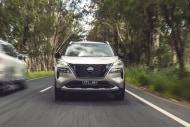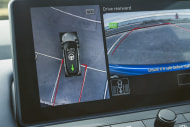
Cars that can park themselves?
Parking assistance systems are becoming increasingly popular in new cars, and as cars get larger and the spaces they have to fit into don’t, this technology is a great way to ensure you can at least get into or out of your car when it’s at the shops.
Believe it or not there are cars that can park themselves. Well, sort of.
- For those who fear parking, there are cars that can effectively do it themselves
- Systems vary between different brands and manufacturers
- Some park while you’re in the car, others can use a “remote control” system
Parking assistance systems are becoming increasingly popular in new cars, and as cars get larger and the spaces they have to fit into don’t, this technology is a great way to ensure you can at least get into or out of your car when it’s at the shops.
It may seem magical and mystical, and to a certain extent it is. That’s because there are typically dozens of sensors working together to effectively tell the car what needs to happen next. In most instances, cars with “smart parking” will have a surround-view camera and sensors around the car to help “measure” the space around the vehicle.
Self-parking systems can call upon ultrasonic sensors, the car’s blind-spot radar system, and other collision avoidance systems and sensors to take in everything that’s happening in the car’s immediate vicinity.

All that data is then processed in real-time by the car’s computer, which - depending on the system - can then manage the engine or motor’s throttle, brakes and/or steering.
There are a few different types of parking assistance systems available:
- Steering assistance - where you need to control throttle, braking and gear selection
- Parking assistance - which can modulate throttle and brake, while steering for you, and you just need to do the gears
- Automated parking - which can you do the lot for you: throttle, brake, steering and gear selection
- Remote parking - where you can use a keyfob or smartphone to pilot the car in and out of a space and start or stop the engine using that controller, too
If you’re experiencing the self-parking tech while still sitting in the driver’s seat, you may need to press a button or give the car a cue to tell it that you want to park (use the indicator at low speeds, for example), and in some instances you don’t even need to select gears.
Most of these systems are designed for cars to park in reverse-parallel spaces - the most dreaded parking manoeuvre of any L-plater (or fully licensed driver, for that matter), and they will primarily use the kerb-side sensors on the car to detect a space and pilot into it.
However, make sure you understand what your car can do, and more importantly, what it can’t, when it comes to ‘self-parking’. Some vehicles require you to still do throttle, brake, and gears - effectively, these are ‘self-steering’ rather than ‘self-parking’.
Others will just need you to apply the brakes when pulling up to the spot with your indicator on, with a display on the centre screen or driver info screen to instruct you on what needs to happen next.

Volkswagen Group was one of the first on the scene with this tech, with its Park Assist system fitted to a plethora of models across its brands. Park Assist, according to VW, “actively helps you 90-degree park, back into a space and get in and out of a parallel park”, by “using sensors on either side of your bumpers, together with front and rear parking distance sensors”.
Other examples include that seen in some European cars, where the car will park itself and even control the gears for the driver. These systems will often require the driver to hit a button (on or near the gear selector, priming the automatic transmission for what it needs to prepare for), and then select what type of parking move is going to be needed.
For instance, on a Peugeot, you need to select Parallel Parking (left or right) or Perpendicular Parking (left or right). It is worth noting that this technology still takes quite a bit of time to initiate. You will need to come to a complete stop, put the gear selector in Neutral, and then allow the car to start the parking sequence.
Nissan also has a system called Intelligent Parking Assist, which is fitted to the Ti grade of the Qashqai, which also requires the driver to control the sequence by first hitting a button, then using the 12.3-inch touchscreen media system to select the augmented reality view of the space they want to fit into. The driver needs to control the gears, throttle and braking, but the screen offers a great view and clear instructions on what needs to be done.
A hat tip to the Ford Ranger ute for being the first pick-up truck with parking assistance available in Australia - it manages that because it has an electronic steering system. It is strictly a steering guidance technology, though - the sensors scan for suitable spots and the driver needs to select Neutral, then the driver must control the ute’s braking and throttle by using the Parking button near the gear selector.
BMW introduced an innovative parking assistance feature in recent years that can reverse you out of a space if you’re not confident to do so. The parking system will remember the last 50 metres you drove forwards, and if you suddenly find yourself at a dead-end on a narrow road, it will follow the path you originally took (provided you didn’t exceed 36km/h).
As for remote parking tech, different systems require the user to choose either forward or backward (drive or reverse) using either the buttons on the car key fob, or their phone.
You might have seen Tesla’s Summon feature in action, where the car will drive itself in and out of parking spaces, steering to avoid potential side-swipes. It is an opt-in feature, and can be controlled by the key fob or your smartphone, and you can “drive” the car forwards or backwards remotely.
Other examples of this tech include Remote Smart Park Assist, which is fitted to some Kia, Hyundai and Genesis models. It uses a set of buttons on the key to allow you to start the engine, and control the car to drive forwards or backwards. As with Tesla, this feature is designed to allow easier access to your car if you’re parked in a tight space.
This tech isn’t perfect - so please use it responsibly, and you will still be liable if the car inadvertently impacts something while the vehicle is performing its function. As a rule of thumb - you’re still driving it, even if you’re not driving it.

More Urban Guide


